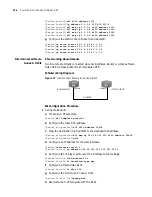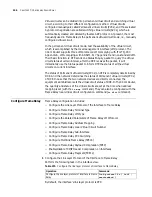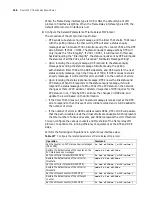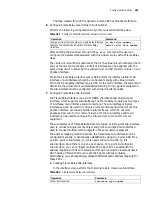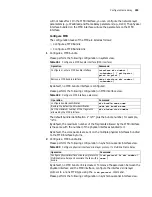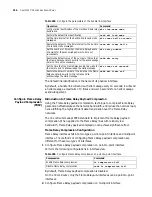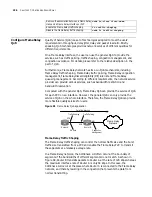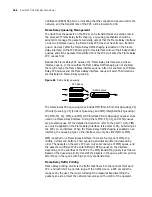
17
C
ONFIGURING
F
RAME
R
ELAY
This chapter contains information on the following topics:
■
Frame Relay Protocol Overview
■
Configure Frame Relay
■
Configure Frame Relay QoS
■
Configure Frame Relay over Other Protocols
■
Display and debug Frame Relay
■
Typical Frame Relay Configuration Example
■
Fault Diagnosis and Troubleshooting of Frame Relay
Frame Relay Protocol
Overview
Frame Relay protocol is a fast-packaging switching technology, which develops on
the basis of X.25 technology. Compared with X.25 protocol, Frame Relay only
implements the core function of the link layer, easily and efficiently.
A Frame Relay network provides capacity of data communication between user
equipment (such as routers and hosts), also called data terminal equipment (DTE).
The equipment that provides access for DTE is data circuit-terminating equipment
(DCE). A Frame Relay network can be a public network, a private enterprise
network, or a network formed by direct connection between data equipment.
The Frame Relay protocol is a statistics multiplexing protocol, providing multiple
virtual circuits on a single physical transmission line. Each virtual circuit is identified
by a DLCI (Data Link Connection Identifier), which is valid only on the local
interface and the corresponding opposite interface. This means that in the same
Frame Relay network, the same DLCI on different physical interfaces does not
indicate the same virtual connection. A user interface in the Frame Relay network
supports up to 1024 virtual circuits, among which the DLCI range available to the
user is 16~1007. As a Frame Relay virtual circuit is connection oriented, different
local DLCIs are connected to different opposite equipment. Therefore, the local
DLCI can be considered as the "Frame Relay address" of the opposite equipment.
Frame relay address mapping associates the opposite equipment's protocol
address with its Frame Relay address (local DLCI), so that the upper layer protocol
can locate the opposite equipment by using its protocol address. Frame Relay
mainly bears IP. In sending IP packet, only the next hop address of the packet can
be obtained from the route table, so this IP address must be used to determine the
corresponding DLCI before sending. This process can be performed by searching
for the Frame Relay address mapping table, because the mapping relation
between the opposite IP address and the next hop DLCI is stored in the address
mapping table. The address mapping table can be manually configured, or
maintained dynamically by the Inverse ARP protocol.
Summary of Contents for 3036
Page 1: ...http www 3com com 3Com Router Configuration Guide Published March 2004 Part No 10014299 ...
Page 4: ...VPN 615 RELIABILITY 665 QOS 681 DIAL UP 721 ...
Page 6: ...2 ABOUT THIS GUIDE ...
Page 7: ...I GETTING STARTED Chapter 1 3Com Router Introduction Chapter 2 3Com Router User Interface ...
Page 8: ...4 ...
Page 16: ...12 CHAPTER 1 3COM ROUTER INTRODUCTION ...
Page 34: ...30 ...
Page 60: ...56 CHAPTER 3 SYSTEM MANAGEMENT ...
Page 98: ...94 CHAPTER 6 DISPLAY AND DEBUGGING TOOLS ...
Page 110: ...106 ...
Page 114: ...110 CHAPTER 8 INTERFACE CONFIGURATION OVERVIEW ...
Page 158: ...154 CHAPTER 10 CONFIGURING WAN INTERFACE ...
Page 168: ...164 ...
Page 188: ...184 CHAPTER 13 CONFIGURING PPPOE CLIENT ...
Page 192: ...188 CHAPTER 14 CONFIGURING SLIP Router ip route static 0 0 0 0 0 0 0 0 10 110 0 1 ...
Page 248: ...244 CHAPTER 16 CONFIGURING LAPB AND X 25 ...
Page 320: ...316 ...
Page 330: ...326 CHAPTER 20 CONFIGURING IP ADDRESS ...
Page 362: ...358 CHAPTER 21 CONFIGURING IP APPLICATION ...
Page 374: ...370 CHAPTER 23 CONFIGURING IP COUNT ...
Page 406: ...402 CHAPTER 25 CONFIGURING DLSW ...
Page 408: ...404 ...
Page 452: ...448 CHAPTER 29 CONFIGURING OSPF ...
Page 482: ...478 CHAPTER 30 CONFIGURING BGP ...
Page 494: ...490 CHAPTER 31 CONFIGURING IP ROUTING POLICY ...
Page 502: ...498 ...
Page 508: ...504 CHAPTER 33 IP MULTICAST ...
Page 514: ...510 CHAPTER 34 CONFIGURING IGMP ...
Page 526: ...522 CHAPTER 36 CONFIGURING PIM SM ...
Page 528: ...524 ...
Page 532: ...528 CHAPTER 37 CONFIGURING TERMINAL ACCESS SECURITY ...
Page 550: ...546 CHAPTER 38 CONFIGURING AAA AND RADIUS PROTOCOL ...
Page 590: ...586 CHAPTER 40 CONFIGURING IPSEC ...
Page 599: ...IX VPN Chapter 42 Configuring VPN Chapter 43 Configuring L2TP Chapter 44 Configuring GRE ...
Page 600: ...596 ...
Page 638: ...634 CHAPTER 43 CONFIGURING L2TP ...
Page 649: ...X RELIABILITY Chapter 45 Configuring a Standby Center Chapter 46 Configuring VRRP ...
Page 650: ...646 ...
Page 666: ...662 ...
Page 670: ...666 CHAPTER 47 QOS OVERVIEW ...
Page 700: ...696 CHAPTER 49 CONGESTION MANAGEMENT ...
Page 706: ...702 CHAPTER 50 CONGESTION AVOIDANCE ...
Page 707: ...XII DIAL UP Chapter 51 Configuring DCC Chapter 52 Configuring Modem ...
Page 708: ...704 ...
Page 762: ...758 CHAPTER 52 CONFIGURING MODEM ...






